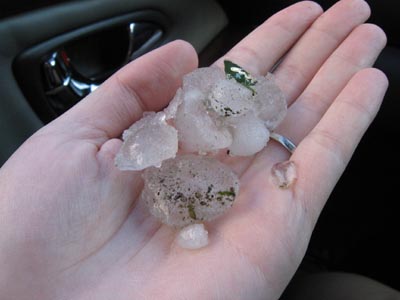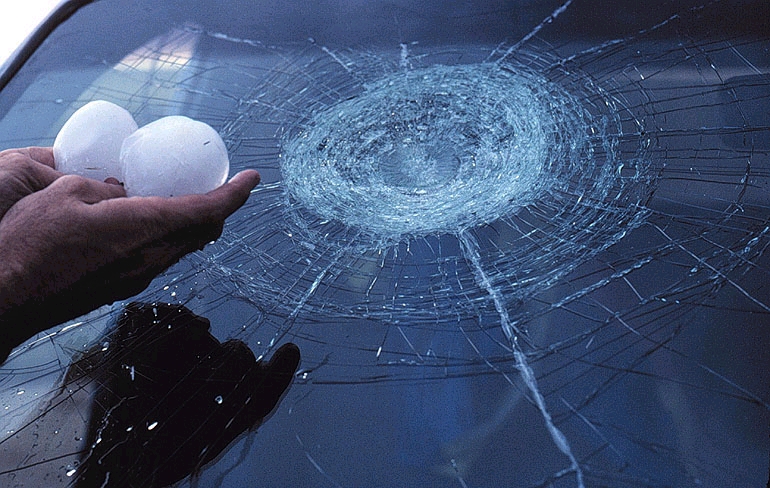
There’s no getting around hail. It hits without warning every year in the United States, says Joe Brennan, owner of Insurance Claims Group Inc. in Cary, N.C.
According to the National Oceanic and Atmospheric Administration, hail causes an average of $1 billion damage to crops and property each year; last year was an especially violent year, causing more than $2 billion in damage.
When predicting how large a hailstone will become and how potentially damaging a hail storm will be, meteorologists say it all depends on the updraft, an upward blowing wind that won’t allow the rain to fall but holds it captive within the higher altitude of the clouds where the temperature is colder.
For a raindrop, a thunderstorm is like being inside an out of control washing machine. Water droplets are thrust up and down and if the agitation is severe enough, droplets soar so high they freeze.
If the storm is violent enough, the droplets take that trip time after time, adding a layer of ice each. When a ball of ice becomes heavy enough – usually between ¼ and ¾ of an inch – it plummets to the ground as hail.
After a free fall from more than 30,000 feet, it hits your roof and everything else at more than 70 miles per hour.
Marble/mothball = 1/2 inch diameter
Dime/Penny = 3/4 inch diameter – hail penny size or larger is considered severe
Nickel = 7/8 inch
Quarter = 1 inch
Ping-Pong Ball = 1 1/2 inch
Golf Ball = 1 3/4 inches
Tennis Ball = 2 1/2 inches
Baseball = 2 3/4 inches
Tea cup = 3 inches
Grapefruit = 4 inches
Softball = 4 1/2 inches
Source: National Oceanic and Atmospheric Administration
For homeowners, hail is unavoidable. “All policies cover hail,” Brennan says. “There is no worry about not being covered. It’s a sudden event we can’t control.”
Brennan says hail coverage is different than hurricane coverage. Hurricanes are more predictable. “In Florida, you have to buy an endorsement for wind damage. Because hurricanes routinely strike Florida, insurance companies don’t include wind damage from hurricanes in their homeowner’s policies.”
Hail is much less predictable and can hit anywhere, which is why it is part of basic coverage in nearly all homeowners insurance policies.The biggest question most homeowners have about hail coverage is how much.
“No one really knows how much because until you get hit, you really won’t know the amount of damage,” Brennan says.
It usually comes down to is how big of deductible a homeowner needs.
“If your deductible is $1,000 and you don’t have $1,000 in the bank, then your deductible is too high,” says Brennan. While some policies offer a deductible that’s a percentage of the damage, Brennan doesn’t recommend it. “If you have $25,000 in damage, that could be $2,500 out of pocket to meet the deductible, and this doesn’t really save you all that much money.”
Anyone whose property is struck by hail needs to have professionals check to make sure there is damage. Not all hail storms cause damage, Brennan says. Pea sized hail (1/4 of an inch) or marble-sized hail (1/2 inch) might not cause damage. Anything larger, say a dime or a quarter (3/4 to one inch) can cause serious damage. Golf ball sized hail is 1 ¾ inches and softball-sized hail is 4 ½ inches according to NOAA. To put this in perspective, hail has to grow to the size of a hen’s egg to dent a car and hail that is half the size of a baseball can kill birds and animals.
Brennan says roof damage is the most difficult to detect because it may be two or three years before the homeowners begin to notice leaks. That discovery doesn’t come until well after the one-year period in which the policyholder has to file a claim.
“Have a professional roofer come by to take a look at your roof. It’s important because it’s not the damage done today that matters,” Brennan says.
One way to check is to look if there is an inordinate amount of aggregate from the shingles in the gutters.
“Before anyone goes up on the roof, find out what the inspection covers. He should make a drawing of the roof with ‘X’ marks for damage and he should take photographs,” Brennan says.
Homeowners also should check window ledges for damage and siding. Vinyl siding, Brennan says, will have holes while damage to wood siding isn’t as noticeable. If there are nicks in the siding it can cause splitting, which will lead to leaks.
Greg Raab, manager of integrated services at Adjusters International in Utica, N.Y., says the first thing homeowners should do – even before a hail storm hits – is a complete review of their policy.
“Make sure you have enough coverage. Nearly all policies cover hail, but with the changes taking place in the housing market and home values increasing, it’s important to make sure you have enough coverage.”
Raab says hail is part of common coverage that most homeowner policies cover. “Even so, most of our complaints come from consumers who are upset that their insurance isn’t covering the amount they thought it should.”
Tom Cipares, president of General Insurance Services in Michigan City, Ind., says hail is a common peril covered by most policies. He says it’s also part of most auto policies if the family car or van is dented during a hail storm.
“It’s easier to see on a vehicle. If it’s dented, it’s got damage,” Cipares says. “But regardless of whether it’s a home or car, anyone with damage should file a claim.”
Cipares says insurance companies know that every year there will be hail damage somewhere and they prepare for it. “It’s important to file a claim with your insurance company. Typically, your rates cannot be adversely affected if you file claim,” Cipares says.
Brennan, of Insurance Claims Group, says that after a storm homeowners need to make sure they do a thorough inspection of their property. After a roof inspection make sure to check the garage, the tool shed, fences, the swimming pool and any other outdoor structures.
“You’ve paid for protection so if the 30-year shingles you put on your roof four years ago are damaged and need to be replaced, that’s 25 years of life from the shingles that you paid for and didn’t get. That’s why you have insurance and why you should file a claim,” Brennan says.













Hi,I check your blog named “Consumer Insurance Guide – Consumer Insurance Guide What the Hail? Misconceptions About Homeowner’s Insurance and Hail Damage” daily.Your humoristic style is awesome, keep it up! And you can look our website about fast proxy list.
You ought to take part in a contest for one of the most useful websites online. I am going to recommend this site!